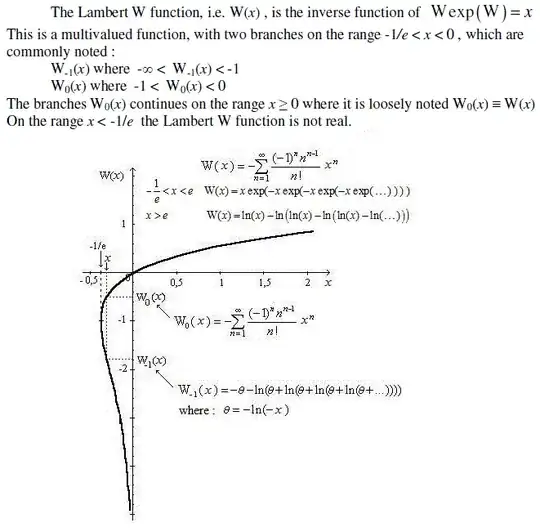Are there other known power series for the Lambert W function, other than this one:
$$W(x) = x-x^2+\frac{3 x^3}{2}-\frac{8 x^4}{3}+\frac{125 x^5}{24}-\frac{54 x^6}{5}+\frac{16807 x^7}{720}-\frac{16384 x^8}{315}+\frac{531441 x^9}{4480}-\frac{156250 x^{10}}{567}+\frac{2357947691 x^{11}}{3628800}-\frac{2985984 x^{12}}{1925}+O\left(x^{13}\right)$$
Series[LambertW[x], {x, 0, 12}]
Edit 30.11.2013:
Is this a valid generalization to any z?
$$W(z) = \text{Log}[z]+\frac{(-2-\text{Log}[z]) (z-z \text{Log}[z])^2}{2 (1+\text{Log}[z]) (z+z \text{Log}[z])^2}+\frac{z-z \text{Log}[z]}{z+z \text{Log}[z]}+\frac{(z-z \text{Log}[z])^3 \left(9+8 \text{Log}[z]+2 \text{Log}[z]^2\right)}{6 (1+\text{Log}[z])^2 (z+z \text{Log}[z])^3}+\frac{(z-z \text{Log}[z])^4 \left(-64-79 \text{Log}[z]-36 \text{Log}[z]^2-6 \text{Log}[z]^3\right)}{24 (1+\text{Log}[z])^3 (z+z \text{Log}[z])^4}+\frac{(z-z \text{Log}[z])^5 \left(625+974 \text{Log}[z]+622 \text{Log}[z]^2+192 \text{Log}[z]^3+24 \text{Log}[z]^4\right)}{120 (1+\text{Log}[z])^4 (z+z \text{Log}[z])^5}+\frac{(z-z \text{Log}[z])^6 \left(-7776-14543 \text{Log}[z]-11758 \text{Log}[z]^2-5126 \text{Log}[z]^3-1200 \text{Log}[z]^4-120 \text{Log}[z]^5\right)}{720 (1+\text{Log}[z])^5 (z+z \text{Log}[z])^6}+...$$
Mathematica:
Clear[x, a, nn, b, z]
nn = 6;
a = Series[Exp[-x], {x, N[Log[z], 50], nn}];
b = Normal[InverseSeries[Series[x/a, {x, 0, nn}]]];
x = z;
b = b
z = Range[4]
N[b, 20]
These numbers appear to be found in the oeis: http://oeis.org/A042977 and the result is known.

